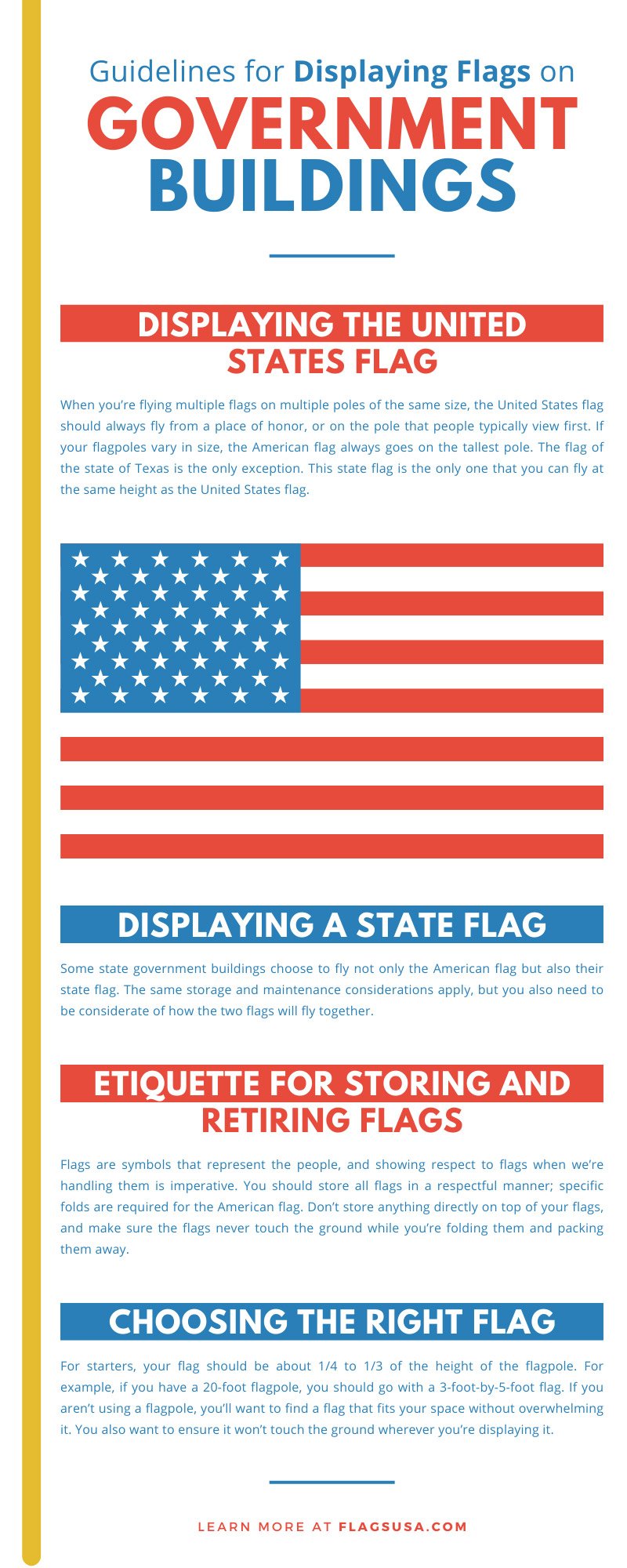No products in the cart.


Many government buildings, including public institutions, public school buildings, and even temporary polling places, display state and national flags every day. These flags represent the people, their cultures, and their pride within their community groups.
If you’re in charge of displaying flags on a government building, you must consider the guidelines below to show respect for our country’s founding leaders and for the people who have sacrificed their lives so that we can live freely and pursue happiness.
Properly displaying flags on government buildings can be tricky. You have to take into account the location of the flags, their sizes, and even where you’ll store them after you put them away at night or during a storm.
The United States Flag Code establishes guidelines for flying flags on federal buildings. These were put in place to make sure that people treat flags with respect and maintain them for repeated use. This article will walk you through the main points.
When you’re flying multiple flags on multiple poles of the same size, the United States flag should always fly from a place of honor, or on the pole that people typically view first. If your flagpoles vary in size, the American flag always goes on the tallest pole. The flag of the state of Texas is the only exception. This state flag is the only one that you can fly at the same height as the United States flag.
Likewise, if you’re hanging multiple flags indoors on a speaker’s platform, you should place the United States flag in the position of honor. The position of honor in this case is the farthest to your right as you face the audience and highest above the other flags in the arrangement; this puts the US flag in its proper function of respect above all other flags present.
If multiple flags are being displayed at the same time, the correct order—beginning at the observer’s left—is the United States flag followed by the flags of other nations. These flags should be flown at the same height. Continuing to the right, state flags and local flags are traditionally flown lower on the pole.
When you’re flying flags at night or during inclement weather, you should always illuminate them in some way. On a government building, you may also have to display your flags at half-staff on certain occasions. Some of those occasions are when a president or other elected official passes away, on days of national mourning, and on Memorial Day, which falls on the last Monday in May.
When you’re displaying the US flag on the wall or window of a government building, you can choose to fly it either horizontally or vertically. More often than not, the layout of your building will determine the orientation of your flag. However you choose to hang the flag, the stars—also known as the Union—should always be in the uppermost corner to the observer’s left.
Some state government buildings choose to fly not only the American flag but also their state flag. The same storage and maintenance considerations apply, but you also need to be considerate of how the two flags will fly together.
For instance, if a state flag is flying on the same pole as the US flag, you should raise the American flag first and lower it last. Furthermore, you’ll often see that state flags are smaller than the US flag. It’s perfectly fine for both flags to be the same size; however, as a sign of honor, state flags can’t be larger than the US flag.
Flags are symbols that represent the people, and showing respect to flags when we’re handling them is imperative. You should store all flags in a respectful manner; specific folds are required for the American flag. Don’t store anything directly on top of your flags, and make sure the flags never touch the ground while you’re folding them and packing them away.
Inspect your flags regularly for tears or holes. It’s crucial that you understand when to retire your flags. When they’re no longer fit for display, you should either destroy or recycle them. Some organizations will collect damaged flags and retire them for you in a ceremony, often close to patriotic holidays. These ceremonies include burning the damaged flags or cutting them into pieces—excluding the Union—and recycling the remains at an appropriate location. You may also be able to retire your flags yourself.
You might also be able to repair your flag in certain cases. Just make sure to use a reputable vendor. Or you may consider simply replacing it with a new one so that there are no discrepancies in color.
For starters, your flag should be about 1/4 to 1/3 of the height of the flagpole. For example, if you have a 20-foot flagpole, you should go with a 3-foot-by-5-foot flag. If you aren’t using a flagpole, you’ll want to find a flag that fits your space without overwhelming it. You also want to ensure it won’t touch the ground wherever you’re displaying it.
Flags can be made of many materials, ranging from cotton to nylon to polyester. Buying a cheaper option can be tempting, but we recommend that you purchase a quality American state flag that reproduces the exact colors and clarity for display. If your primary concern is durability, we recommend a sewn polyester flag, which can last up to six months when flown outdoors.
Of course, you don’t have to fly your flag outdoors. You can hang indoor flags in the halls of your building, while you can use small flags to decorate reception desks. Indoor flags tend to last longer, requiring little maintenance or handling.
You should take all these guidelines into consideration when you’re displaying a state or national flag on a government building. All 50 state flags differ, but they all share a common purpose: to represent their people. Raise your flags high and honor them each day.
